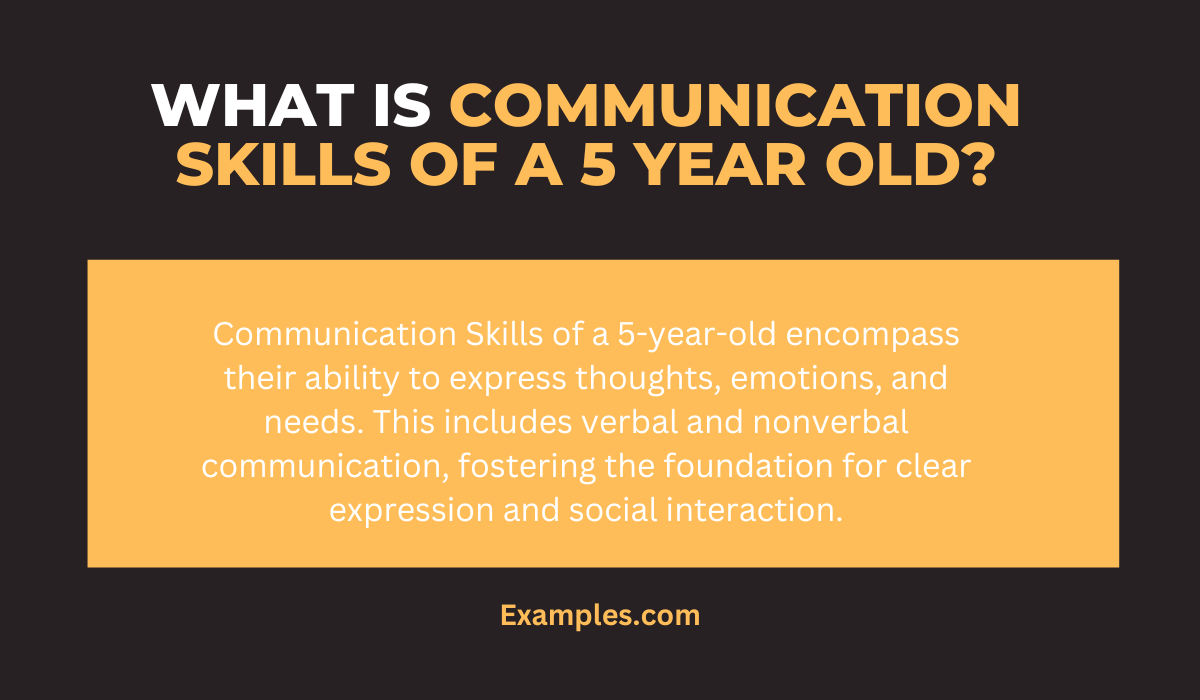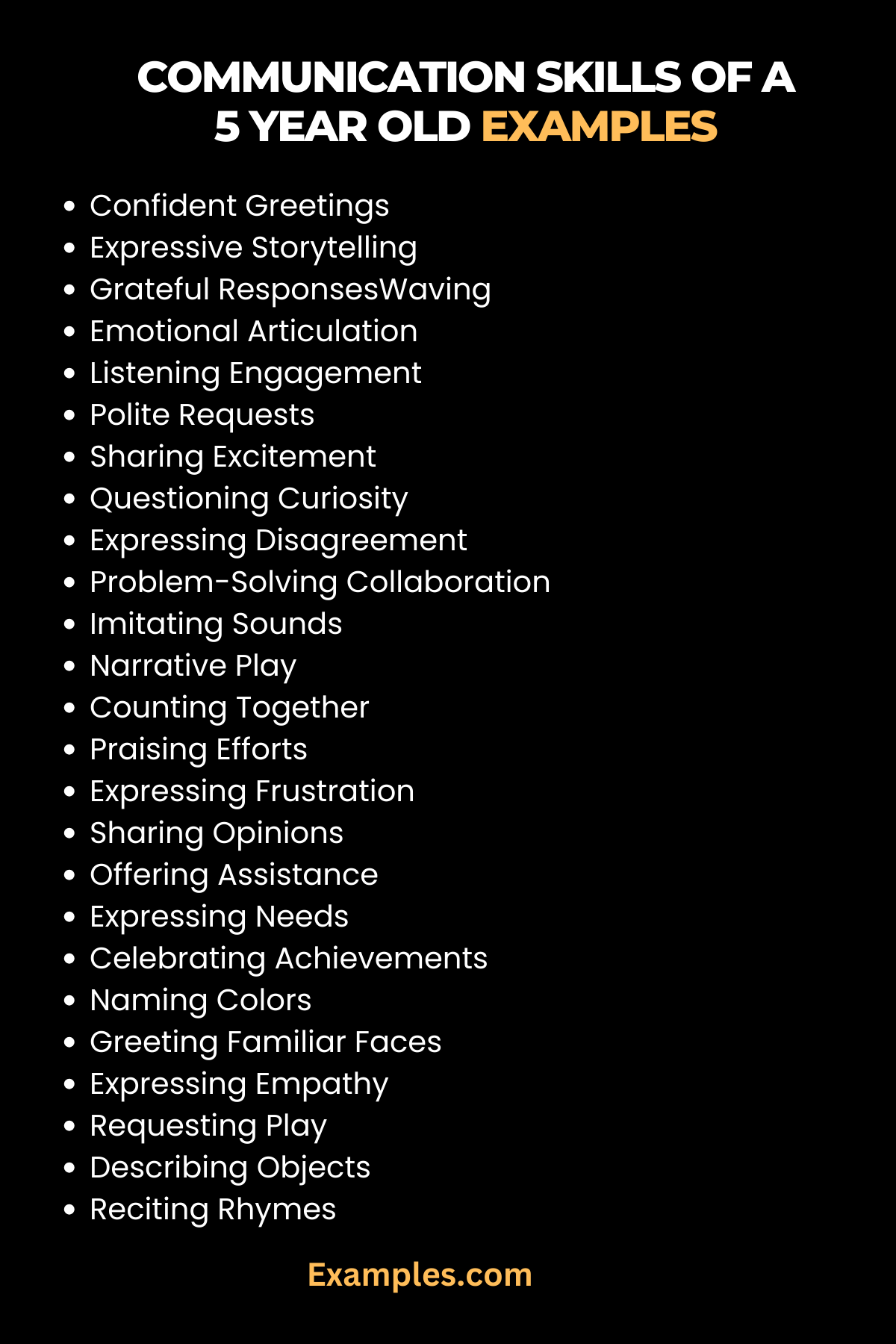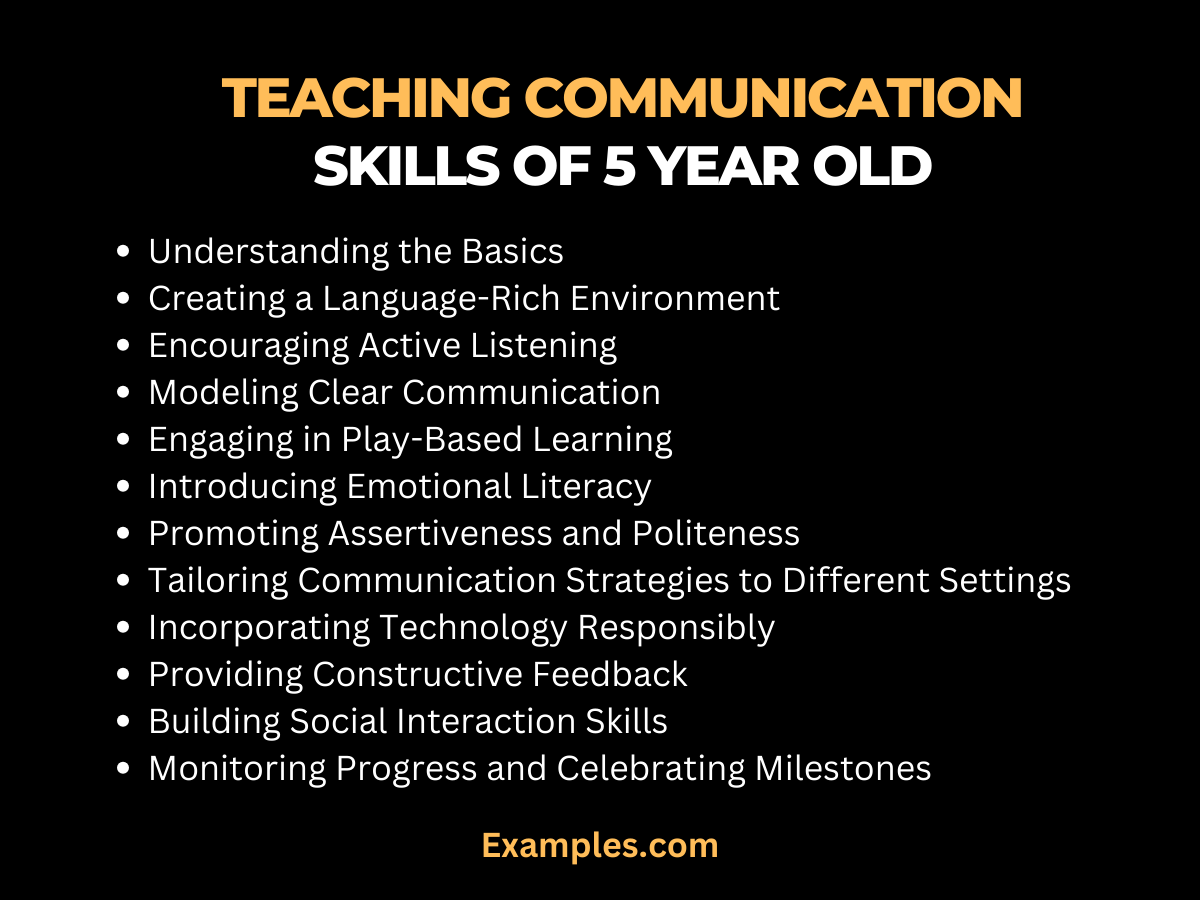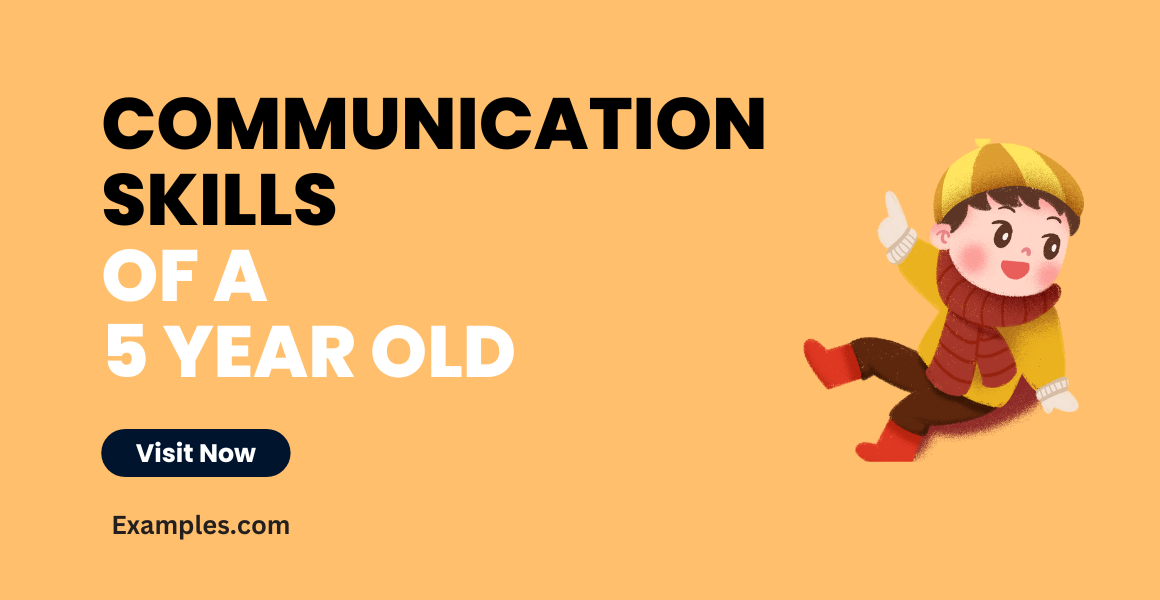29+ Communication Skills of a 5 year old Examples
Unlock the wonders of nurturing Communication Skills in 5-year-olds with our comprehensive guide! Explore this complete resource offering valuable insights and expertly curated examples to foster effective communication in your child. Dive into a world where “Communication Examples” come to life, guiding you through practical tips and strategies. Empower your 5-year-old with the tools they need for confident expression and social interaction. 🌟👦
What is Communication Skills of a 5 Year old?
Communication skills in a 5-year-old refer to their ability to express thoughts, feelings, and needs effectively. In simple terms, it involves verbal and nonverbal interactions, showcasing their understanding and engagement with the world around them. These skills lay the foundation for clear expression, social interactions, and emotional intelligence, crucial for their developmental journey. Understanding the nuances of a 5-year-old’s communication skills is key to supporting their growth and fostering positive connections.

What is the Best Example of Communication Skills of a 5 Year Old?
5-year-old confidently articulating their thoughts, emotions, and needs with clarity and enthusiasm. The best example of communication skills in a 5-year-old involves their ability to express themselves effectively, whether through spoken words, gestures, or facial expressions. It’s the joy of witnessing them share ideas, interact with others, and navigate social situations with confidence. This exemplifies the blossoming of communication skills, a crucial aspect of their developmental journey.
30 Communication Skills of a 5 Year Old Examples
Explore a treasure trove of 30 exemplary Communication Skills of a 5-year-old, each narrating a unique story of expressive brilliance. Our curated collection provides a rich blend of SEO-friendly insights and NLP-enhanced tips, ensuring your child’s communication journey is both enriching and engaging. Dive into this resource to empower your little one with the art of effective expression.

- Confident Greetings: Boldly say “hello” with eye contact, teaching politeness and connection.
- Expressive Storytelling: Share imaginative tales, fostering creativity and language development.
- Grateful Responses: Thank someone with a warm “thank you,” instilling gratitude and manners.
- Emotional Articulation: Label feelings like “happy” or “sad” to develop emotional intelligence.
- Listening Engagement: Respond appropriately to others, promoting active listening skills.
- Polite Requests: Ask for help using phrases like “please,” cultivating politeness.
- Sharing Excitement: Exclaim “wow” with enthusiasm, showcasing genuine excitement.
- Questioning Curiosity: Pose questions like “why” or “how,” encouraging curiosity and learning.
- Expressing Disagreement: Politely disagree with phrases like “I don’t think so,” promoting assertiveness.
- Problem-Solving Collaboration: Collaborate by saying “let’s figure this out together,” fostering teamwork.
- Imitating Sounds: Mimic animal sounds, enhancing auditory discrimination and fun communication.
- Narrative Play: Role-play different characters, nurturing creativity and storytelling.
- Counting Together: Count items collaboratively, integrating communication with learning.
- Praising Efforts: Encourage others with “great job,” building a positive communication style.
- Expressing Frustration: Use words like “I’m upset” instead of tantrums, promoting emotional regulation.
- Sharing Opinions: Express thoughts with “I like” or “I don’t like,” developing personal expression.
- Offering Assistance: Volunteer help with “can I help you?” teaching empathy and cooperation.
- Expressing Needs: Use phrases like “I’m hungry” or “I need help,” fostering independence.
- Celebrating Achievements: Celebrate success with “I did it,” boosting self-esteem and confidence.
- Naming Colors: Identify colors accurately, enhancing language and cognitive development.
- Greeting Familiar Faces: Warmly greet family members with personalized greetings.
- Expressing Empathy: Say “I’m sorry” when needed, developing compassion and understanding.
- Requesting Play: Invite peers with “let’s play,” encouraging social interaction.
- Describing Objects: Provide detailed descriptions with phrases like “it’s big and blue.”
- Reciting Rhymes: Recite nursery rhymes, enhancing language rhythm and memory.
- Asking Permission: Seek permission with phrases like “can I do this?” promoting respect.
- Giving Compliments: Offer kind words like “you look nice,” fostering positive communication.
- Expressing Preferences: Share preferences with “I want” or “I prefer,” asserting personal choices.
- Explaining Imaginary Play: Describe imaginative scenarios, fostering creative expression.
- Reciprocal Conversations: Engage in back-and-forth dialogues, building conversational skills.
How to Teach Communication Skills of 5 Year Old?
In the pivotal phase of early childhood development, fostering effective communication skills in a 5-year-old is instrumental. This guide offers a strategic approach to cultivate clear expression, active listening, and social interaction in your little one.

Understanding the Basics: Communication Skills of a 5-Year-Old Begin by recognizing the age-appropriate communication milestones and the spectrum of verbal and nonverbal cues that contribute to a 5-year-old’s expressive abilities.
Creating a Language-Rich Environment Immerse your child in a language-rich atmosphere. Surround them with diverse vocabulary, engage in storytelling, and encourage open conversations to enhance language development.
Encouraging Active Listening Teach the art of active listening through interactive activities and games. Foster the habit of focused attention, response acknowledgment, and comprehension in various contexts.
Modeling Clear Communication Become a communication role model for your child. Demonstrate effective communication through articulation, expression, and the use of appropriate body language.
Engaging in Play-Based Learning Utilize play as a powerful tool for learning. Incorporate activities that involve turn-taking, sharing ideas, and expressing emotions, facilitating natural communication development.
Introducing Emotional Literacy Guide your 5-year-old in recognizing and expressing emotions. Provide a vocabulary for various feelings, encouraging them to articulate their emotional experiences.
Promoting Assertiveness and Politeness Teach assertiveness by empowering your child to express their needs and opinions confidently. Instill politeness through the use of phrases like “please” and “thank you.”
Tailoring Communication Strategies to Different Settings Help your child adapt their communication style to diverse situations, such as home, school, and social gatherings. Foster flexibility and understanding of various social norms.
Incorporating Technology Responsibly Introduce age-appropriate technology that supports language development. Select interactive apps and educational games that engage your child in constructive communication.
Providing Constructive Feedback Offer positive reinforcement and constructive feedback to encourage improvement. Focus on praising effort, acknowledging achievements, and gently guiding them through communication challenges.
Building Social Interaction Skills Facilitate opportunities for your 5-year-old to engage with peers. Encourage group activities, playdates, and collaborative projects to enhance their social communication skills.
Monitoring Progress and Celebrating Milestones Regularly assess your child’s communication development. Celebrate milestones and progress, reinforcing their sense of accomplishment and fostering a positive attitude towards communication.
How to Communicate With a 5 Year Old?
Navigating communication with a 5-year-old requires a thoughtful approach to foster understanding and connection. Here’s a comprehensive guide tailored to optimize “Communication Skills of a 5-year-old,” ensuring meaningful interactions:
- Establish Eye Contact and Proximity: Begin conversations by getting down to their eye level, enhancing engagement and conveying attentiveness.
- Use Simple Language: Opt for straightforward and age-appropriate language to facilitate comprehension and encourage active participation.
- Encourage Open-Ended Questions: Foster dialogue by asking questions that prompt more than a simple “yes” or “no,” allowing for expressive responses.
- Active Listening: Demonstrate attentiveness through active listening, acknowledging their thoughts and feelings with genuine interest.
- Incorporate Visual Aids: Enhance understanding by incorporating visuals, such as pictures or props, to support verbal communication.
- Engage in Playful Communication: Utilize play as a communication tool, integrating activities that encourage verbal expression during imaginative play.
- Reinforce Positive Behavior: Acknowledge and praise effective communication, reinforcing positive behavior to encourage continued development.
- Provide Choices: Offer simple choices to empower decision-making, promoting autonomy and communication in decision processes.
- Narrate Daily Activities: Describe daily routines and activities, aiding language development and connecting language to real-life experiences.
- Be Patient and Allow Processing Time: Recognize that 5-year-olds may take a moment to formulate responses; be patient and allow processing time.
- Use Imaginative Language: Embrace creativity by incorporating imaginative and descriptive language, fostering a love for storytelling.
- Emphasize Emotional Expression: Encourage the verbalization of emotions, teaching them to identify and express feelings effectively.
- Model Polite Communication: Demonstrate polite communication by using “please” and “thank you,” instilling good manners.
- Share Personal Stories: Connect through personal stories, creating a bond and providing relatable examples for effective communication.
- Celebrate Achievements: Acknowledge milestones in their communication journey, fostering a positive and supportive environment.
How Many Words Should a 5-Year-Old Know?
As parents, understanding the expected vocabulary range for a 5-year-old is vital for fostering robust communication skills. On average, a 5-year-old should know around 1,500 words, encompassing everyday terms, descriptive language, and basic concepts. This guide delves into the factors influencing word acquisition, strategies to enrich vocabulary, and milestones to track your child’s linguistic development.
Factors Influencing Vocabulary Growth:
Several factors influence a 5-year-old’s vocabulary development. Explore the impact of environmental stimuli, social interactions, and cognitive abilities on language acquisition. Discover how a child’s exposure to diverse experiences and engaging conversations contributes to the expansion of their communication skills.
Strategies for Enriching a 5-Year-Old’s Vocabulary:
Empower your child’s linguistic journey with practical strategies. From reading aloud and interactive storytelling to incorporating new words into daily activities, explore creative ways to enhance their vocabulary. This section provides actionable tips to create an enriching linguistic environment at home, fostering a love for language exploration.
Milestones in 5-Year-Old Language Development:
Track your child’s language milestones with precision. Understand the typical linguistic achievements expected at age 5, from sentence complexity and storytelling skills to the use of descriptive language. This guide ensures you stay attuned to your child’s progress, allowing you to celebrate each linguistic milestone along their developmental path.
Promoting Effective Communication Skills:
Beyond vocabulary quantity, focus on the quality of communication. Learn how to encourage clarity, coherence, and expression in your child’s speech. Explore activities that promote effective communication, laying the groundwork for confident self-expression and successful social interactions.
Interactive Language Games for 5-Year-Olds:
Make language development a delightful journey through engaging games. From word association activities to storytelling challenges, this section provides a curated list of interactive games designed to make learning enjoyable. These games not only reinforce vocabulary but also nurture essential communication skills in a fun and interactive way.
Creating a Language-Rich Environment at Home:
Transform your home into a language-rich haven. Uncover practical tips for fostering a communicative atmosphere that stimulates your 5-year-old’s language growth. From creating a diverse bookshelf to initiating meaningful conversations, discover ways to cultivate an environment that nurtures their evolving communication skills.
What are Communication Skills in Early Childhood?
In the developmental journey of a 5-year-old, communication skills lay the groundwork for their social, emotional, and cognitive growth. This comprehensive guide delves into the intricacies of “Communication Skills of a 5-year-old,” shedding light on their significance, components, and ways to nurture these vital skills.
Defining Communication Skills in Early Childhood: Communication skills encompass the ability to express thoughts, feelings, and needs effectively. In early childhood, these skills manifest through verbal and nonverbal communication, forming the basis for interaction with family, peers, and the broader world.
Key Components of Communication Skills in a 5-year-old:
- Verbal Expression: Developing vocabulary and articulating ideas with words.
- Nonverbal Communication: Mastering gestures, facial expressions, and body language.
- Active Listening: Engaging attentively and responding appropriately to others.
- Social Interaction: Navigating conversations and building connections with peers.
- Emotional Expression: Conveying feelings and understanding others’ emotions.
Significance of Early Childhood Communication Skills:
- Foundation for Academic Success: Proficient communication enhances language development, a precursor to academic achievements.
- Social Competence: Builds the groundwork for positive interactions, forming strong social bonds.
- Emotional Intelligence: Fosters the ability to recognize and express emotions, crucial for emotional well-being.
- Cognitive Development: Supports cognitive growth by encouraging expression and comprehension.
- Preparation for Later Years: Sets the stage for advanced language and communication skills in the future.
Nurturing Communication Skills in a 5-year-old:
- Encourage Expression: Create a supportive environment for verbal and artistic expression.
- Model Effective Communication: Demonstrate clear communication and active listening.
- Provide Varied Social Experiences: Facilitate interactions with peers, fostering social skills.
- Read Aloud Together: Enhance vocabulary and comprehension through shared reading.
- Engage in Imaginative Play: Stimulate creativity and language development through pretend play.
Challenges and Solutions:
- Speech Development Delays: Consult with a speech-language pathologist for early intervention.
- Social Interaction: Hurdles Organize playdates and social activities to enhance social skills.
- Emotional Expression: Difficulties Encourage emotional vocabulary and validate their feelings.
How Can I Improve 5 Year old’s Communication Skills?
Communication skills are a vital aspect of a child’s development, laying the groundwork for successful social interactions and self-expression. Here’s a detailed guide on how to enrich and improve the communication skills of your 5-year-old:
- Create a Language-Rich Environment: Surround your child with diverse language stimuli, including books, conversations, and engaging activities. Exposure to varied vocabulary enhances linguistic capabilities.
- Encourage Storytelling: Foster a love for storytelling by encouraging your child to narrate their experiences or create imaginative tales. This nurtures creativity and language proficiency.
- Active Listening Practices: Model and encourage active listening. Respond attentively to your child, reinforcing the importance of listening and responding appropriately.
- Engage in Conversations: Initiate and participate in conversations with your child. This builds their conversational skills, teaching them turn-taking and the art of meaningful dialogue.
- Use Imaginative Play: Incorporate imaginative play, like pretending to be different characters. This not only makes communication enjoyable but also enhances language development.
- Expand Vocabulary with Word Games: Introduce word games and vocabulary-building activities. Play games that involve naming objects, describing them, or finding words that rhyme.
- Express Emotions: Teach your child to express emotions using words. Help them identify and articulate their feelings, fostering emotional intelligence.
- Promote Politeness and Manners: Emphasize the importance of polite communication. Encourage phrases like “please” and “thank you,” instilling good manners from an early age.
- Celebrate Individuality: Support your child’s unique communication style. Acknowledge and celebrate their individual expression, promoting confidence in communication.
- Model Clear Communication: Be a role model for effective communication. Demonstrate clear articulation, proper pronunciation, and the use of varied sentence structures.
- Encourage Questions: Cultivate curiosity by welcoming questions. Responding positively to inquiries encourages your child to explore and communicate more.
- Utilize Educational Resources: Leverage educational resources, such as age-appropriate books, videos, and interactive games that focus on language development.
- Integrate Communication into Daily Activities: Seamlessly integrate communication skills into everyday activities. Whether during mealtime, playtime, or outings, find opportunities for conversation.
- Provide Constructive Feedback: Offer constructive feedback on communication efforts. Positive reinforcement and gentle correction contribute to continual improvement.
- Engage in Multisensory Learning: Incorporate multisensory experiences into learning. Activities that involve touch, sight, and sound enhance overall language development.
In conclusion, fostering Communication Skills in a 5-year-old is a journey of discovery and growth. This comprehensive guide, enriched with vivid examples, equips parents and caregivers to nurture effective communication. Embrace the joy of witnessing your child express themselves confidently, setting the stage for a lifetime of positive interactions and successful communication. 🌈👦



